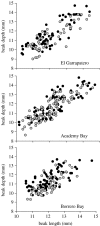Possible human impacts on adaptive radiation: beak size bimodality in Darwin's finches
- PMID: 16822748
- PMCID: PMC1797601
- DOI: 10.1098/rspb.2006.3534
Possible human impacts on adaptive radiation: beak size bimodality in Darwin's finches
Abstract
Adaptive radiation is facilitated by a rugged adaptive landscape, where fitness peaks correspond to trait values that enhance the use of distinct resources. Different species are thought to occupy the different peaks, with hybrids falling into low-fitness valleys between them. We hypothesize that human activities can smooth adaptive landscapes, increase hybrid fitness and hamper evolutionary diversification. We investigated this possibility by analysing beak size data for 1755 Geospiza fortis measured between 1964 and 2005 on the island of Santa Cruz, Galápagos. Some populations of this species can display a resource-based bimodality in beak size, which mirrors the greater beak size differences among species. We first show that an historically bimodal population at one site, Academy Bay, has lost this property in concert with a marked increase in local human population density. We next show that a nearby site with lower human impacts, El Garrapatero, currently manifests strong bimodality. This comparison suggests that bimodality can persist when human densities are low (Academy Bay in the past, El Garrapatero in the present), but not when they are high (Academy Bay in the present). Human activities may negatively impact diversification in 'young' adaptive radiations, perhaps by altering adaptive landscapes.
Figures





References
-
- Abbott I, Abbott L.K, Grant P.R. Comparative ecology of Galápagos ground finches (Geospiza Gould): evaluation of the importance of floristic diversity and interspecific competition. Ecol. Monogr. 1977;47:151–184.
-
- Benkman C.W. Divergent selection drives the adaptive radiation of crossbills. Evolution. 2003;57:1176–1181. - PubMed
-
- Bowman R.I. Morphological differentiation and adaptation in the Galápagos finches. Univ. Calif. Publ. Zool. 1961;58:1–302.
-
- Bradshaw W, Holzapfel C. Genetic shift in photoperiodic response correlated with global warming. Proc. Natl Acad. Sci. USA. 2001;98:14 509–14 511. 10.1073/pnas.241391498 - DOI - PMC - PubMed
-
- Brewer M.J. Discretisation for inference on normal mixture models. Stat. Comput. 2003;13:209–219. 10.1023/A:1024214615828 - DOI
Publication types
MeSH terms
LinkOut - more resources
Full Text Sources
Miscellaneous

